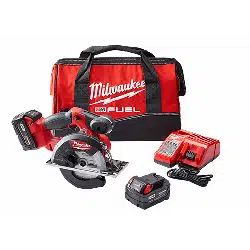Loading ...
Loading ...
Loading ...

7
APPLICATIONS
WARNING
Chips, dirt, and debris can cause
the lower guard to hang up at any
time. Return the saw to a MILWAUKEE service
facility for cleaning and testing.
This tool is intended for cutting unhardened ferrous
metal and non-ferrous metal. The following precau-
tions must be followed to reduce the risk of injury:
• Do not cut stacked materials. Cut one piece at a time.
• Do not cut hardened steel.
• Cut materials with the wider edge of the shoe over
the clamped side of the material.
• Do not touch the saw blade, workpiece, or cutting
chips with bare hands immediately after cutting; they
may be hot and could burn skin.
• Adjust the cutting angle of the blade to the workpiece,
so the blade goes through the thinnest sections.
Cutting Angled Materials
When cutting angled materials, tilt the tool back to
avoid having the lower guard rest on the angle.
Correct Technique
Incorrect Technique
Cutting Thin or Corrugated Materials
Cut thin and corrugated materials at least 1" from the
edge of the workpiece to avoid injury or damage to
the tool caused by thin strips of metal being pulled
into the upper guard.
Cutting Large Sheets
Large sheets sag or bend if they are not correctly
supported. If you attempt to cut without leveling and
properly supporting the workpiece, the blade will tend
to bind, causing kickback.
Support large sheets. Be sure to set the depth of the
cut so that you only cut through the workpiece, not
through the supports.
When cutting widths greater than 4", clamp or tack
1" lumber to workpiece and use the inside edge of
the shoe as a guide.
WARNING
To reduce the risk of electric shock,
check work area for hidden pipes
and wires before making pocket cuts.
Pocket Cutting
Pocket cuts are made in the middle of the workpiece
when it can not be cut from an edge. We recommend
using a SAWZALL
®
reciprocating saw or jig saw for
this type of cut. However, if you must use a circular
saw to make a pocket cut, USE EXTREME CAU-
TION. To maintain control of the saw during pocket
cutting, keep both hands on the saw.
1. Beginning at a corner, line up the sight line with
your cutting line. Tilt the saw forward, rmly xing
the front of the shoe on the workpiece. The blade
should be just above cutting line, but not touching it.
Raise the lower guard using the lower guard lever.
2. To start the saw, push the lock-o button down
while pulling the trigger. Allow the motor to reach
full speed before beginning cut. Using the front
of the shoe as a hinge point, gradually lower the
back end of the saw into the workpiece. Release
the lower guard lever and grasp the front handle.
3. When the shoe rests flat against workpiece,
advance the saw to the far corner. Release
the trigger and allow the blade to come to a
complete stop before removing it from work-
piece. Repeat the above steps for each side of
the opening. Use a SAWZALL
®
reciprocating
saw, jig saw or small hand saw to finish the
corners if they are not completely cut through.
Troubleshooting
If the blade does not follow a straight line:
•Teeth are dull. This is caused by hitting a hard
object such as a nail or stone, dulling teeth on one
side. The blade tends to cut to the side with the
sharpest teeth.
•Shoe is out of line or bent
•Blade is bent
•Blade is loose.
If the blade binds, smokes or turns blue from friction:
•Blade is dull
•Blade is on backwards
•Blade is bent
•Blade is dirty
•Workpiece is not properly supported
•Incorrect blade is being used
•Battery charge is low
Loading ...
Loading ...
Loading ...
